- Valmik Thapar, author of "The Secret Life of Tigers" commenting on the future of tigers in the wild
|
Introduction Curiously, he is gentile and quiet, but at the same time his low growl warns you that this encounter can be deadly as well. Powerful and charismatically handsome, the tiger is a superb animal! |
|
|
|
I have always been fascinated with tigers. As a child, I remember going to the circus and I can recall how captivated I was by the sight of the tigers entering the arena to perform for the crowd. The ringmaster would always make them snarl and growl with a swift crack of his whip as if by exposing their enormous canines would somehow add to the drama of the moment. How differently I look at tigers today. Having just returned from visiting two major game parks in India, I've come back with a completely different view of the legendary cats as well as having a special reverence for them. Ranthambhore, the first of the two parks I visited, was a long way from my childhood memories. Located near the town of Sawai Madhopur, Ranthambhore encompases nearly 152 square miles of deciduous forest in southwestern Rajasthan. It has become one of the most important tiger habitats in the world, a place where tigers can be seen regularly and in the daytime. The park itself covers some 400 sq km and its scenery is very beautiful. A system of lakes and rivers are hemmed in by steep high crags and on top of one of these is the extensive and well-preserved Ranthambhore Fort, built in the 10th Century when it was a vital citadel for the control of central India. -LE. |
| Tiger Tales | |
|
Once upon a time people came to these forests to shoot tigers. But India in the 1990s is a different place. The emphasis now is on conservation.There is a growing concern in India for the conservation of their rich heritage of wildlife and to preserve the environment from irreparable damage. Numbers of tigers have dramatically decreased due to excessive hunts during the last hundred years from an estimated 50,000 at the turn of the century to a mere 1827 in 1972. |
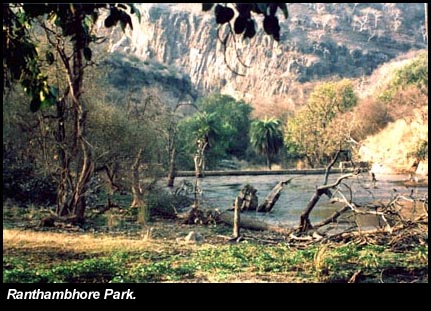 |
| But from 1973, Project Tiger has considerably restored some of the lost numbers and the tiger population in India is now estimated to be around 4500. With these figures in mind, I felt the compelling need to see and photograph tigers in the wild before they vanished completely from the landscape. | |
|
Leaving our lodge just
before daybreak, we arrived at the entrance to the park to pick
up our ranger and then set off in search of tigers! The landscape
is dotted with chital (spotted deer) which is the favorite prey
of tigers and large troups of langur monkeys sound the alarm
as we pass nearby interupting their morning feeding. Following the advise of our guide, we "listen to the sounds of the forest" and hope that it will let us know when the tiger is near! From our open-sided jeeps driven by park rangers our eyes search the woods for any sign of the elusive cat. We watch for any movement, any sound. Suddenly, the forest erupts with alarm calls. A chital looks sharply toward the forest. It is frozen in its tracks. The loud shrill of a peacock breaks the silence and is joined by another and together their frequent alarm calls now alert the entire forest. Although the tiger is still invisible to me, I can sense that he is near. He is a master of disguise and his striped coat blends beautifully into the surrounding landscape. Walking effortlessly among the brush and fallen leaves, the tiger is finally visible as our guide yells out "tiger walking!" to alert anyone in the area. Our first tiger sighting is a magnificent male and as he emerges from the forest he continues to walk parallel to our vehicle for several yards. I am flush with excitment! To see a tiger in the wild is one of the most thrilling experiences nature has to offer. It is the biggest of the big cats and a symbol of strength. Because of its elusive nature, much of the Indian tiger's activity takes place behind a veil of tall jungle grass or within dense foliage where it is dangerous to be on foot. Bandhavgarh, our second national park, would allow us the privilege of riding on elephant back which would give us a much closer view of the tiger. As our tiger crosses the road in front of our vehicle, he continues his steady gate and as silently as he appeared, disappears into the forest. It is a humbling experience and I am thrilled to see my first tiger in the wild! |
 |
 |
|
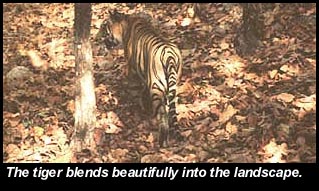 |
|
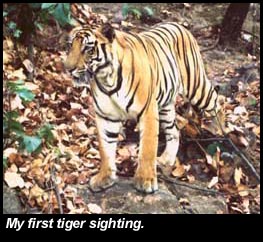 |
|
Beautiful Bandhavgarh Set among the Vindhya Hills
of Madhya Pradesh with an area of 168 square miles, Bandhavgarh
National Park contains a wide variety of habitats and high density
of game, including large numbers of tigers. Majastic Sal Forests
cover half the area and there are stretches of bamboo and grassland
as well. In Bandhavgarh we were
fortunate to have the forest elephants available to us for our
morning safaris. Riding elephant back is the only way to safely
spot and follow a tiger in the wild. At our rendezvous point
we watched as our elephants suddenly appeared at the edge of
the forest with their mahouts mounted just above their ears.
Mounting these hugh elephants was no easy task but you soon learned
the technique. With one small step onto the top of the jeep and
one hugh step onto the narrow platform high up on the side of
the elephant, you pray that you are in the correct seating position
before the elephant takes off on his trek into the forest. |
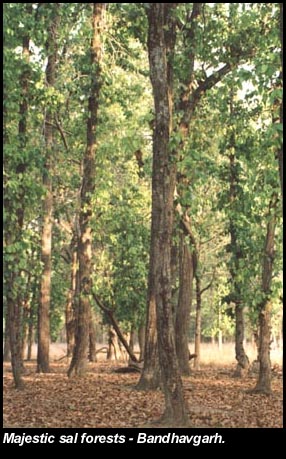 |
 |
| Seeing the tigers in the wild is a sight few will ever have the opportunity to experience. Being a lover of animals, there is a sense of joy in being able to watch these magnificent cats in their natural habitat. The more closely one observes their world, the more convinced we become that animals have a right to be here too. We can only hope that with the efforts of many, the tiger will not become extinct and will continue to thrive in the magical forests of India. |
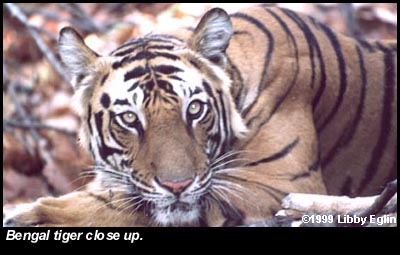 |
|
Tiger Population World Wide The Siberian Tiger, also called the Amur tiger, is the largest, most powerful cat in the world. These tigers live mostly in eastern Russia. Only about 400 Siberian tigers live in the wild. The South China Tiger is the most endangered of all tigers. Fewer than 20 of these tigers now live in the wild, and only 50 live in zoos. In China, the tiger is a symbol of power and is a favorite subject of artists. The Bengel is the most common tiger. They live throughout India, although some are found in neighboring countries to the north and east. Today, most Bengel tigers live on game preserves and are thought to number 5000. The Indochinese Tiger lives in the hilly and mountainous forests of Thailand and neighboring countries. They may weigh over 400 lbs. About 1500 of these tigers now live in the wild. The Sumatran Tiger is the smallest member of the tiger family. The Sumatran tiger has many thin stripes, which help it hide in the dense jungle forest. These tigers like water and are good swimmers. Less than 400 said to be left in the wild. Javan Tiger EXTINCT Bali Tiger EXTINCT Caspian Tiger EXTINCT |
|
The following books make excellent tiger reading: Of Tigers and Men by Richard Ives The Secret Life of Tigers by Valmick Thapar Tigers in the Snow by Peter Matthiessen |
